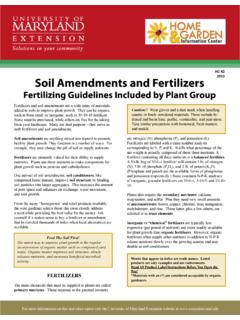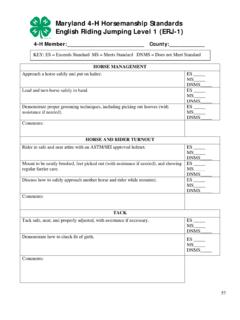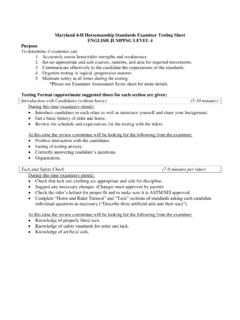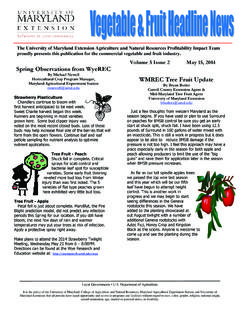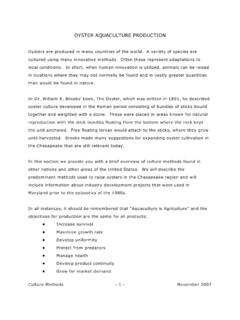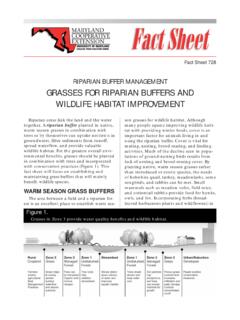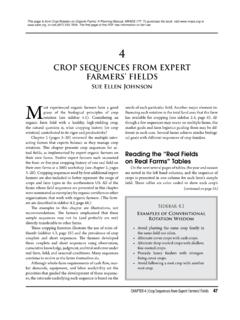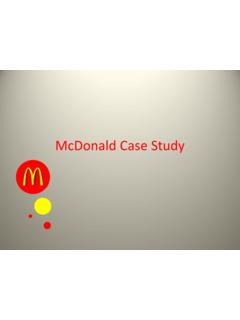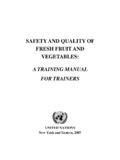Transcription of VINEGAR: AN ALTERNATIVE TO GLYPHOSATE
1 vinegar : AN ALTERNATIVE TO GLYPHOSATE ? Deborah Smith-Fiola, Independent IPM Consultant, Landscape Enterprise, LLC. and Stanton Gill, Extension Specialist, IPM for Nurseries and Greenhouses University of Maryland Extension Central Maryland Research and Education Center INTRODUCTION. GLYPHOSATE is the chemical name of world's most widely used and best-selling herbicide. It is used in more than 130 countries on agricultural crops, orchards, nurseries, greenhouses, lawns, landscapes, rights-of-way, Over 100 million pounds are applied to farms and lawns every year, according to the EPA.
2 In the home and garden sector, it is the second most-used pesticide, with over 5 million pounds used per year. In golf courses and turfgrass maintenance, 5- 8 million pounds of GLYPHOSATE are used each year. One landscape maintenance industry survey1. attested that GLYPHOSATE may account for up to 90% of pesticide applications in landscape beds. GLYPHOSATE was patented by Monsanto under the trade name RoundUp' in 1974. GLYPHOSATE is now widely available from many manufacturers under numerous trade names after patent protection ended in 2000: RoundUp, KleenUp, Accord, Imitator, Eraser, Pronto, Rodeo, There are over 750 products containing GLYPHOSATE for sale in the , according to the National Pesticide Information Center.
3 GLYPHOSATE [N-(phosphonomethyl) glycine, the isopropylamine salt of GLYPHOSATE ] is a non-selective, post-emergent, broad-spectrum systemic herbicide. When applied to growing plants, it is absorbed by foliage and translocated to the roots, where it blocks the production of a specific enzyme pathway needed for plant growth. Wilting and death occur within ~7-10 days. After application, GLYPHOSATE binds tightly to soil particles, becoming immobilized so it can no longer harm plants. Due to no residual soil activity, a crop can be seeded or transplanted into the soil soon after application.
4 It is ultimately broken down in the soil by microorganisms into ammonium and carbon dioxide. As a non-selective herbicide, GLYPHOSATE will kill most plants it contacts. Accordingly, it can be used for vegetation cleanup prior to all types of planting, field/bed/turfgrass preparation or renovation. It can be spot sprayed for general weed control or sprayed directly over top of specific crops at certain times of year ( over Christmas trees/conifers in the fall). No other herbicide works as well on perennial grasses as GLYPHOSATE does, particularly late in the season.
5 TOXICITY. Because GLYPHOSATE does not leach through soil and has low mammalian toxicity, it has been considered to be very safe toxicologically and environmentally, with hundreds of studies showing the active ingredient to be less acutely toxic than common table salt or aspirin. The EPA does not consider GLYPHOSATE to be a human carcinogen. However, much of GLYPHOSATE 's touted low- toxicity is based only upon studies of the active ingredient, not the other inert ingredients in a formulation. Different GLYPHOSATE products vary in the type of active ingredient salt and the manufacturer proprietary compounds included in the formulated products.
6 Proprietary compounds are listed on the label as inert ingredients and used for handling convenience, for easier mixing with other pesticides, and/or for aiding movement of the active ingredient from the leaf surface into the plant tissue ( surfactants). RoundUp, for example, is 41% GLYPHOSATE and 59% inert ingredients. Products range from RTU formulations (KleenUp, etc.) to concentrates of active GLYPHOSATE . The EPA is currently conducting a standard registration review of GLYPHOSATE and has set a deadline of 2015 for determining future use limits. VIABLE alternatives TO GLYPHOSATE ?
7 Due to environmental, regulatory action, and increasing consumer concerns, green industry professionals as well as homeowners are seeking viable alternatives to GLYPHOSATE . ALTERNATIVE , non-chemical, natural, organic herbicides are available commercially. These products mimic natural plant based chemicals; they generally have low toxicity and break down rapidly in the environment. They can be used selectively to control weeds by spraying, painting or drenching. However, they tend to be expensive, have no residual activity, and may have quality differences from batch to batch.
8 Commercially available ALTERNATIVE products rarely generate 100% weed control. They perform better on broadleaf weeds than grassy weeds. They are best used in conjunction with optimizing cultural practices such as improving soil health, turf/plant nutrition, irrigation, cultivar selection, proper moving, and seeding/plant establishment and overseeding. Avoiding conditions that favor weeds (compacted soils, overwatering, excessive or ill-timed nitrogen applications) and adjusting soil pH to favor desirable plants over weeds increased effectiveness. Most ALTERNATIVE herbicide products are not chemicals, so they are exempt from EPA pesticide registration.
9 As a result, many have little or no ecotoxicity or worker exposure data available. Several can be harmful to people/pets during mixing and application, owing to inhalation, skin or eye contact, or spray mist. Some have unpleasant smells or have an allergenic effect. For example, corn gluten meal should not be used by anyone with corn allergies. ALTERNATIVE herbicides fall into 7 product categories: Natural acids ( vinegar + citric acids), Herbicidal soaps, Iron-based herbicides, Salt-based herbicides, phytotoxic oils (clove, peppermint, pine, citronella), corn gluten, and combination products (including ingredients from multiple categories).
10 This fact sheet concentrates specifically on acetic acid ( vinegar ) products. USING ALTERNATIVE HERBICIDES. ALTERNATIVE herbicides are generally considered contact herbicides, not systemic. They generally work by burning plant foliage, but only foliage that is contacted by the product (although chelated iron products claim weed kill down to the root). They only kill weeds that have emerged and have no residual activity on those emerging after application. Most are fast acting (15. minutes) when temperature is high (>85 F), and particularly if humidity is low.
